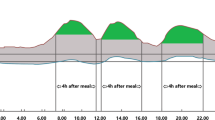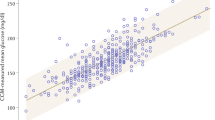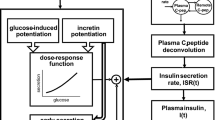Abstract
Hyperglycaemia is the diagnostic criterion and a main prognostic parameter in diabetes. Epidemiological and intervention studies have defined the target values for glycaemic control, and there is general consensus that antihyperglycaemic treatment should aim at reducing HbA1c levels below 7%. In order to achieve this goal it is important that the entire daily glucose profile is reduced. This can be accomplished only by therapies designed to tackle both basal and postprandial hyperglycaemia. However, an increasing bulk of data suggest that postprandial glucose may be even more deleterious that fasting hyperglycaemia in determining the risk for long-term diabetic complications. A strong association has been recognized for a long time between 2 h post-oral glucose tolerance test (OGTT) glucose levels and mortality and cardiovascular disease. Although these data cannot be directly extrapolated to daily life conditions, excessive glucose excursion after the ingestion of a meal seems to be a common phenomenon even in treated diabetic individuals. Rapid-acting insulin analogues, used as the prandial component insulin replacement therapy and short-acting insulin secretagogues, targeting postprandial glucose control, may have a useful new role to play in the management of diabetes mellitus. These interventions have successfully limited postprandial glycaemic exposure, but evidence is still awaited that these outcomes will translate into prognostic benefits. Other components have to be considered in the search for strict glycaemic control. Diabetic patients with similar HbA1c values may differ in term of glucose stability. Data are available that suggest that patients with larger glucose fluctuation within the day and from day-to-day may be exposed to greater risk of diabetic complications. Therefore, in designing strategies to reduce the burden of diabetic complication both a quantitative effect of hyperglycaemia (fasting, postprandial hyperglycaemia, and HbA1c) as well as a qualitative component (glucose stability) should be taken into account.
This is a preview of subscription content, access via your institution
Access options
Subscribe to this journal
Receive 12 print issues and online access
$259.00 per year
only $21.58 per issue
Buy this article
- Purchase on Springer Link
- Instant access to full article PDF
Prices may be subject to local taxes which are calculated during checkout
Similar content being viewed by others
Author information
Authors and Affiliations
Corresponding author
Rights and permissions
About this article
Cite this article
Del Prato, S. In search of normoglycaemia in diabetes: controlling postprandial glucose. Int J Obes 26 (Suppl 3), S9–S17 (2002). https://doi.org/10.1038/sj.ijo.0802172
Published:
Issue Date:
DOI: https://doi.org/10.1038/sj.ijo.0802172
Keywords
This article is cited by
-
Serum ErbB2 concentration positively correlated to the glycemic variations in newly diagnosed Type 2 diabetic patients
Scientific Reports (2022)
-
Metformin add-on continuous subcutaneous insulin infusion on precise insulin doses in patients with type 2 diabetes
Scientific Reports (2018)
-
Male Patients with Longstanding Type 2 Diabetes Have a Higher Incidence of Hypoglycemia Compared with Female Patients
Diabetes Therapy (2018)
-
Young onset type 2 diabetic patients might be more sensitive to metformin compared to late onset type 2 diabetic patients
Scientific Reports (2017)
-
Features of glycemic variations in drug naïve type 2 diabetic patients with different HbA1c values
Scientific Reports (2017)



